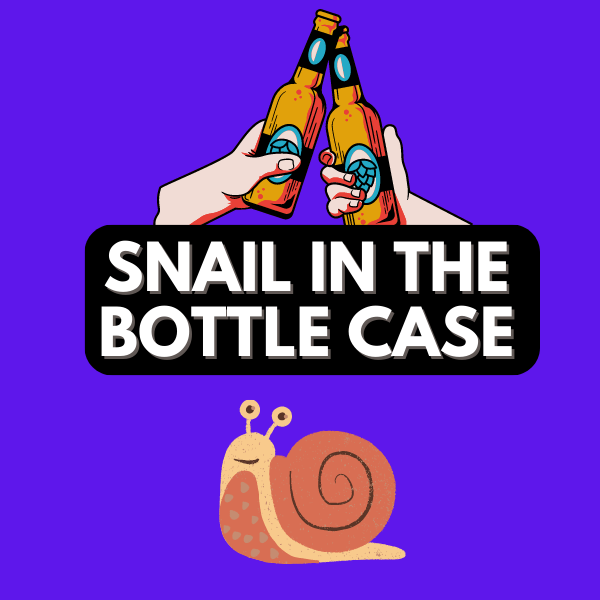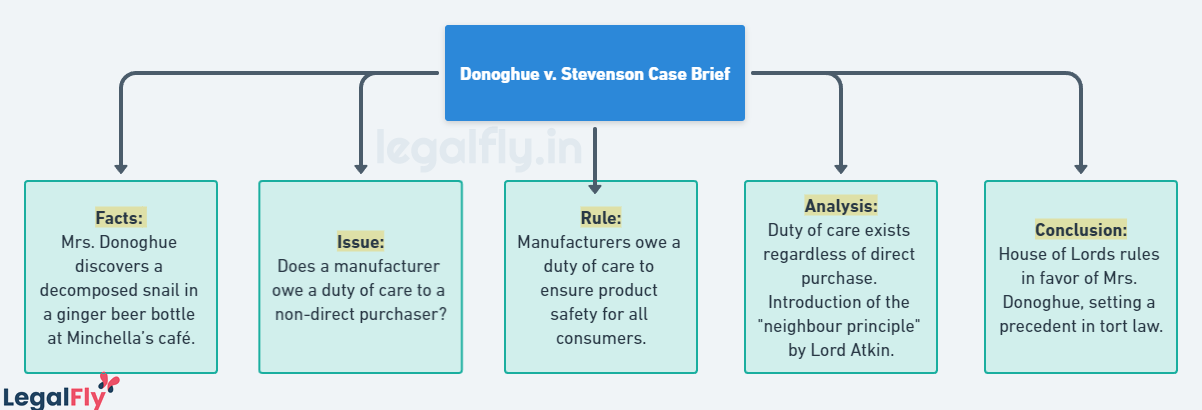Case Name: Donoghue v. Stevenson Court: House of Lords Year: 1932
Citation: 1932 AC 562
Table of Contents
Introduction: The Curious Case of the Ginger Beer Bottle
Imagine sipping on a refreshing bottle of ginger beer on a warm day, only to find an unexpected and unsavory guest at the bottom of your drink—a decomposed snail. This was the shocking reality for Mrs. May Donoghue in 1932, setting the stage for one of the most groundbreaking legal battles in the annals of tort law.
The “Donoghue v. Stevenson” case, often called the “Snail in the Bottle Case,” didn’t just make headlines for its peculiar circumstances and laid the very foundation of the modern concept of negligence. As you delve into this article, you’ll uncover the twists and turns of this landmark case and discover how a simple bottle of ginger beer reshaped the legal landscape, emphasizing the duty of care manufacturers owe to consumers. So, hold onto your drinks and prepare for a legal journey that began with an unsuspecting sip.
This landmark case shaped the modern concept of negligence and underscored the importance of duty of care in tort law.
Historical Background
In the 1930s, the legal landscape was steadily evolving, with many cases setting precedents that would shape the future of law. Among these was the incident that took place in Paisley, now referred to as the “Paisley Snail Incident.”
Mrs. Donoghue, while at Wellmeadow café, was served a bottle of ginger beer purchased by her friend. The bottle’s opaque nature concealed its contents, preventing any view of its contents. To Mrs. Donoghue’s dismay, after consuming a portion of the drink, she discovered the decomposed remains of a snail. This unfortunate event caused her immediate distress, leading to severe gastroenteritis and setting the stage for a significant legal battle. The bottle’s label identified Mr. Stevenson as the manufacturer, making him the defendant in the subsequent case. This incident would go on to challenge established norms and play a pivotal role in the development of the doctrine of negligence.
Case Details: Donoghue v. Stevenson 1932 AC 562
- The Issue of Negligence: Mrs. Donoghue claimed that Mr. Stevenson was negligent in his duty to ensure that snails did not enter the ginger beer bottles and that each bottle was adequately inspected. This negligence, she argued, directly led to her distress and illness.
- The Duty of Care: Central to the case was the question of whether a manufacturer owed a duty of care to the end consumer, mainly when the product was sold through a distributor. The House of Lords, in their judgment, affirmed that such a duty did indeed exist. Lord Atkin, in particular, introduced the “neighbour principle,” emphasizing that individuals must exercise reasonable care to avoid actions or omissions that could foreseeably harm others.
- The Verdict: The House of Lords ruled in favour of Mrs. Donoghue, establishing that Mr. Stevenson, as the manufacturer, owed a duty of care to her. This duty was breached, leading to her harm. The case set a precedent, emphasizing that manufacturers must ensure the safety of their products, especially when consumers have no means of examining them before use.
Legal Proceedings and Arguments
Initial Court Decisions and Appeals
Upon initiating the legal proceedings, Mrs. Donoghue faced an uphill battle. The initial court decisions were not in her favour, primarily because there was no direct contractual relationship between her and Mr. Stevenson, the manufacturer. She hadn’t purchased the ginger beer herself; her friend had. This posed a significant challenge, as the established law at the time primarily limited negligence claims to situations where a contractual relationship existed. Undeterred, Mrs. Donoghue appealed the decisions, leading the case to higher courts and eventually to the House of Lords.
Arguments Presented by Both Sides
Mrs. Donoghue’s primary argument was centered on the negligence of Mr. Stevenson. She claimed he had a duty of care to ensure no harmful contaminants, like the decomposed snail, were present in the ginger beer bottles. This duty, she argued, was breached, leading directly to her distress and illness.
On the other hand, Mr. Stevenson’s defense hinged on the absence of a direct contractual relationship with Mrs. Donoghue. His legal team argued that since she hadn’t directly purchased the ginger beer, there was no duty of care owed to her. They also emphasized the lack of precedent for such a claim without a contract.
The Role of Precedent and Its Challenge
The case’s journey to the House of Lords was not just about Mrs. Donoghue’s personal grievance but also about challenging the established legal norms. The reliance on contractual relationships to develop a duty of care was a well-entrenched precedent in the legal system. However, this case posed a fundamental question: Should manufacturers owe a duty of care to consumers, even if there’s no direct contractual relationship?
The House of Lords, in their deliberations, grappled with this question. They considered their decision’s moral and societal implications, understanding that their ruling would set a precedent for future cases. The challenge to the established norms was profound, leading to re-evaluating the principles of negligence and duty of care.
The Legacy of Donoghue v. Stevenson: The Landmark Judgment
Establishing the Modern Concept of Negligence:
Before this case, the concept of negligence was tethered to direct contractual relationships. However, the ruling in Donoghue v. Stevenson revolutionized this understanding. It established that a duty of care could exist even without a contract. The case became the bedrock upon which the modern version of negligence in tort law was built. It underscored the essence of duty of care and illuminated the ramifications of its breach. In nature, it expanded the scope of who could be considered liable and under what circumstances, paving the way for countless negligence claims in subsequent years.
Influence on Product Liability:
The case had a profound impact on the realm of product liability. The ruling sent a clear message to manufacturers: they bear a significant responsibility toward consumers. This responsibility is especially pronounced for products that cannot be inspected before use, like the opaque ginger beer bottle in the Donoghue case. Manufacturers were now legally obligated to ensure their products were safe for consumption. This shifted the dynamics of consumer protection, placing a greater onus on manufacturers to uphold safety standards and be more vigilant in their production processes.
Lord Atkin’s “Neighbour Principle”
Perhaps one of the most enduring legacies of the case is Lord Atkin’s “neighbour principle.” This principle transcended the confines of the case and became a foundational tenet in tort law. Lord Atkin eloquently articulated the moral and legal obligations individuals owe to each other in society. He posited that individuals must take reasonable care to avoid actions or omissions that could foreseeably harm their “neighbours” – not just in the literal sense, but anyone who could be affected by one’s actions. This principle served as a moral compass, reminding individuals of their inherent responsibilities towards one another in a civilized society.
Practical Tips for Law Students: Studying the Donoghue v. Stevenson Case
- Importance of understanding the historical context.
- Analyzing the arguments: A critical thinking exercise.
- Role-playing: Putting oneself in the shoes of Mrs. Donoghue or Mr. Stevenson.
- Connecting the case to modern-day scenarios: Real-world applications.
At LegalFly, we aim to simplify complex legal topics with creative and unique study diagrams. We’re excited to share the following Mind Map to help you study the Donoghue v. Stevenson Case.
Conclusion
The Donoghue v. Stevenson case isn’t just about a snail in a drink. It’s a critical case that changed how we see negligence in law. Its impact is still felt today, especially when discussing the “neighbour principle.” This case reminds us that law is not just about rules but also about our duties to each other in society.
This case isn’t merely about a snail in a drink. It was a pivotal moment that reshaped our understanding of negligence in law. This case is a powerful reminder of how a single event can bring about significant changes in the legal landscape. Its lasting influence, especially the “neighbour principle,” emphasizes that law goes beyond mere rules, highlighting our responsibilities to one another in society. Reflecting on this landmark case underscores historical judgments’ profound impact and enduring relevance in shaping our legal principles today.
References: https://web.archive.org/web/20010310002750/http://www.leeds.ac.uk/law/hamlyn/donoghue.htm https://en.wikipedia.org/wiki/Donoghue_v_Stevenson https://www.scienzegiuridiche.uniroma1.it/sites/default/files/docenti/alpa/Donoghue_Stevenson.pdf







